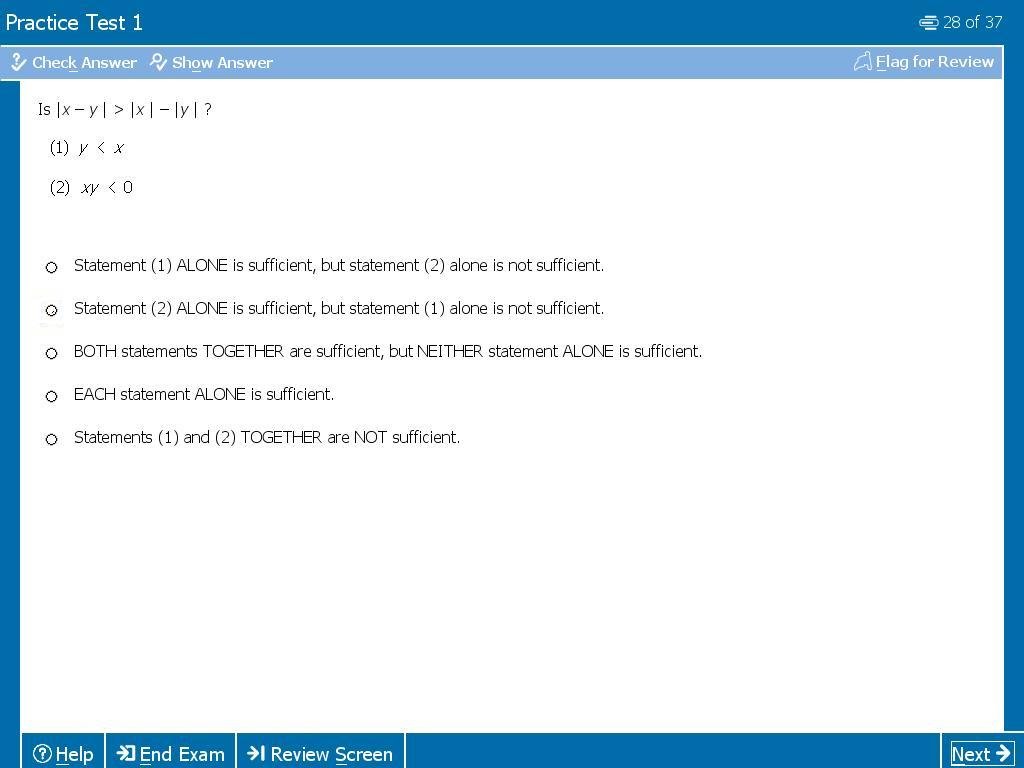Events & Promotions
|
|

GMAT Club Daily Prep
Thank you for using the timer - this advanced tool can estimate your performance and suggest more practice questions. We have subscribed you to Daily Prep Questions via email.
Customized
for You
Track
Your Progress
Practice
Pays
Not interested in getting valuable practice questions and articles delivered to your email? No problem, unsubscribe here.
- Nov 20
07:30 AM PST
-08:30 AM PST
Learn what truly sets the UC Riverside MBA apart and how it helps in your professional growth - Nov 20
01:30 PM EST
-02:30 PM IST
Learn how Kamakshi achieved a GMAT 675 with an impressive 96th %ile in Data Insights. Discover the unique methods and exam strategies that helped her excel in DI along with other sections for a balanced and high score. - Nov 19
12:30 PM EST
-01:30 PM EST
Learn how Keshav, a Chartered Accountant, scored an impressive 705 on GMAT in just 30 days with GMATWhiz's expert guidance. In this video, he shares preparation tips and strategies that worked for him, including the mock, time management, and more - Nov 22
11:00 AM IST
-01:00 PM IST
Do RC/MSR passages scare you? e-GMAT is conducting a masterclass to help you learn – Learn effective reading strategies Tackle difficult RC & MSR with confidence Excel in timed test environment - Nov 23
11:00 AM IST
-01:00 PM IST
Attend this free GMAT Algebra Webinar and learn how to master the most challenging Inequalities and Absolute Value problems with ease. - Nov 24
07:00 PM PST
-08:00 PM PST
Full-length FE mock with insightful analytics, weakness diagnosis, and video explanations! - Nov 25
10:00 AM EST
-11:00 AM EST
Prefer video-based learning? The Target Test Prep OnDemand course is a one-of-a-kind video masterclass featuring 400 hours of lecture-style teaching by Scott Woodbury-Stewart, founder of Target Test Prep and one of the most accomplished GMAT instructors.
B
Be sure to select an answer first to save it in the Error Log before revealing the correct answer (OA)!
Difficulty:
 55%
(hard)
55%
(hard)
Question Stats:
60% (01:48) correct 40%
(02:02)
wrong
40%
(02:02)
wrong  based on 6436
sessions
based on 6436
sessions
History
Date
Time
Result
Not Attempted Yet
Is |x - y| > |x| - |y|?
(1) y < x
(2) xy < 0

3_DS_Absolute_B.JPG [ 56.35 KiB | Viewed 247303 times ]
(1) y < x
(2) xy < 0
Attachment:
3_DS_Absolute_B.JPG [ 56.35 KiB | Viewed 247303 times ]
Kudos
Bookmarks
mmphf
Is |x-y|>|x|-|y|?
Probably the best way to solve this problem is plug-in method. Though there are two properties worth to remember:
1. Always true: \(|x+y|\leq{|x|+|y|}\), note that "=" sign holds for \(xy\geq{0}\) (or simply when \(x\) and \(y\) have the same sign);
2. Always true: \(|x-y|\geq{|x|-|y|}\), note that "=" sign holds when \(x \leq y \leq 0\) or when \(0 \leq y \leq x\). So, essentially when \(xy \geq 0\) AND \(|x| \geq |y|\). (Our case)
So, the question basically asks whether we can exclude "=" scenario from the second property.
(1) y < x --> we cannot determine the signs of \(x\) and \(y\). Not sufficient.
(2) xy < 0 --> "=" scenario is excluded from the second property, thus \(|x-y|>|x|-|y|\). Sufficient.
Answer: B.
Kudos
Bookmarks
Basically the question asks whether the distance between the two points x and y on the line is greater than the difference between the individual distances of x and y from 0.
Is |x - y| > |x| - |y|?
(1) \(y<x\), 3 possible cases for \(|x-y|>|x|-|y|\):
Two different answers. Not sufficient.
(2) \(xy<0\), means \(x\) and \(y\) have different signs, hence 2 cases for \(|x-y|>|x|-|y|\):
In both cases inequality holds true. Sufficient.
Answer: B.
Is |x - y| > |x| - |y|?
(1) \(y<x\), 3 possible cases for \(|x-y|>|x|-|y|\):
- A. \(0<y<x\):
---------------\(0\)---\(y\)---\(x\)---
In this case \(|x-y|>|x|-|y|\) becomes \(x-y>x-y\), which gives \(0>0\). Which is wrong;
B. \(y<0<x\):
---------\(y\)---\(0\)---------\(x\)---
In this case \(|x-y|>|x|-|y|\) becomes \(x-y>x+y\), which gives \(y<0\). Which is right, as we consider the range \(y<0<x\);
C. \(y<x<0\)
---\(y\)---\(x\)---\(0\)--------------
In this case \(|x-y|>|x|-|y|\) becomes \(x-y>-x+y\), which gives \(x>y\). Which is right, as we consider the range \(y<x<0\).
Two different answers. Not sufficient.
(2) \(xy<0\), means \(x\) and \(y\) have different signs, hence 2 cases for \(|x-y|>|x|-|y|\):
- A. \(y<0<x\)
----\(y\)-----\(0\)-------\(x\)---
In this case \(|x-y|>|x|-|y|\) becomes \(x-y>x+y\), which gives \(y<0\). Which is right, as we consider the range \(y<0<x\);
B. \(x<0<y\)
----\(x\)-----\(0\)-------\(y\)---
In this case \(|x-y|>|x|-|y|\) becomes \(-x+y>-x-y\), which gives \(y>0\). Which is right, as we consider the range \(x<0<y\).
In both cases inequality holds true. Sufficient.
Answer: B.

















